The Ultimate Guide to Chicken

It’s the second most consumed meat in the world. It is versatile, protein rich and very low in fat. It goes with everything and everything goes with it.
…Also, according to at least one blockbuster movie, it tastes like everything.
Yes, we’re talking about chicken. From finger lickin’ KFC goodness and Friday night takeaway meals, to well-stuffed Sunday roasts and the £35-per kilogram volaille de Bresse favoured by French President Emmanuel Macron.
According to recent UN figures, there are as many as 21,744,361,000 chickens being kept as livestock all around the world. That’s many times more than the combined amount of cows, sheep, goats or pigs being kept as livestock.
Chickens are pretty amazing creatures – and that’s before we even get to their eggs!
So please join us for this celebration of all things chicken. We hope it’ll be clucking brilliant!
What you will learn:
- What is Chicken?
- A Quick History of Chicken
- Farming Methods: Organic, Free Range and Battery.
- Different Breeds of Chicken (& What They do Best)
- Different Cuts of Chicken
- Chicken hygiene
- How to Cook Chicken
- What Flavours Best Compliment Chicken?
- Which is Better, Breasts or Legs?
- Health Benefits of Eating Chicken
- Chickens in Popular Culture
- Hats Off to the Chickens!
1. What is Chicken?
The chicken (or Gallus gallus domesticus – to give it its proper name) is a type of domestic fowl. The chicken has a higher global population than any other bird in the world.
Chickens are a subspecies of red junglefowl (Gallus gallus), which was possibly hybridized with grey junglefowl (Gallus sonneratii) at some point in prehistory. Evidence suggests that this occurred as far back as 8,000 years ago, but nobody knows for sure.
What we do know is that these birds originated in India and East Asia, which is where they were first tamed and specifically bred for food. Molecular evidence tells us that humans have been eating chicken – or its wild ancestors – for at least 58,000 years.

2. A Quick History of Chicken
Archaeological evidence tells us fairly conclusively that humans in China have been keeping chickens since at least 3600 BCE. Some archaeologists claim that this practice goes back as far back as 5400 BCE, but these claims are controversial. In any instance, chickens have been domesticated for long enough as to be considerably different from their junglefowl ancestors.
To cite a few examples, domesticated chickens tend to be larger and far more docile than their wild counterparts. They sport simpler plumage and begin to lay (much larger) eggs, in far greater numbers, from a considerably earlier age.
In some cases, chickens are capable of producing around 300 eggs a year. According to The Guinness Book of World Records 2011, the highest rate of egg laying on record for a chicken is 371 eggs produced over 364 days. Phew!
In West Asia, Europe and elsewhere, it appears that chickens were initially seen as exotic animals. They were kept primarily for cockfighting and/or special sacrifices as opposed to food. Widespread chicken consumption in Europe did not begin until the Hellenistic period (4th – 2nd centuries BCE).
From about 300BCE, however, farmers in both Egypt and China had developed basic incubators. It was at this point that more people started eating eggs, as egg production became easier. Presumably, more chickens were also being kept at this point, which may have led to an increased consumption of their meat.
3. Farming Methods: Organic, Free Range and Battery.
The term ‘poultry’ refers to any domestic fowl, including ducks, geese and turkeys that are raised for the production of meat or eggs. The word also refers to the flesh of these animals when eaten as food.
Chickens that are farmed primarily for their eggs are known as ‘layer hens’, while those raised for meat are referred to as ‘broilers’. Juvenile hens (less than 28 days of age) are sometimes slaughtered and sold as poussin. NOTE: this term is mainly used in Great Britain and Commonwealth countries. In the United States, the term refers to a different bird, which is usually slaughtered at an older age.
A healthy chicken’s life expectancy can run to between 6 and 8 years, however chickens raised for meat are never allowed to live that long. Broilers are usually killed at around 6 or 8 weeks of age, while a larger bird may be between 11 and 15 weeks of age at the time of slaughter.
The oldest chickens known include Matilda, who lived to be 16 years old (and attained a considerable level of celebrity as a result of both her age and her stage work with her magician owners) and Blacky, who lived to be 22 years old (but apparently didn’t do as much).
After around 12 months of egg production, a layer hen’s ability to produce eggs begins to decline and its body starts showing signs of wear. If allowed to live, hens will lay inconsistently (if at all) after 3 years. After this time, the hens are gassed to death, with their bodies either being destroyed or rendered into other products. Sometimes they are used as pet food.
Occasionally layer hens are harvested for meat, but since they are many times older (and their muscles have worked harder) than the average broiler. Their meat is not considered to be especially tasty, so this doesn’t happen very often.
Modern chicken farming can take different forms, but the most common methods include organic, free range and battery.
To officially qualify as ‘organic‘, the chicken must only be fed organic feed (e.g. food grown without the use of chemicals or pesticides). Additionally, an organic chicken must never receive antibiotic treatment for illness and must be allowed outside at regular intervals. Though the actual health benefits of eating organic chicken have been called into question, it is certainly more ethical than battery farming.
Free-range farming requires the animals to have a degree of space (no more than 13 birds are allowed per square metre) and be allowed outside in the daytime (with access to fresh vegetation) for at least half their lives. They are also not slaughtered until around 14 weeks of age.
Battery farming largely concerns layer hens, and involves keeping the animals in cages for the majority of their lives. This method of farming is technically illegal under EU law, which insists that cages must be at least 45CM high and contain at least 750CM of space.
In many cases, the chickens have their beaks trimmed at birth to prevent vent pecking and cannibalism by animals that are experiencing extreme stress. The animals are usually kept inside and under low light, meaning that they never actually see the sun. In some cases, hens are purposefully starved of food and water, which causes their feathers to moult, but reinvigorates egg production.
Despite being banned in many countries, battery farming still occurs around the world and remains the cruellest and least humane method of obtaining meat and eggs.
4. Different Breeds of Chicken (& What They do Best)
Worldwide, there are hundreds of different varieties of chicken. The American Poultry Association formally recognizes around 65 breeds, while the British Poultry Council recognises 93. However, there are obviously more than this. Similarly with breeds of dog, it is impossible to say with much certainty how many there actually are.
The most well known breed of chicken (and the one you’ve probably eaten the most of) is known as the Cobb 500. The Cobb is popular with farmers because it is relatively cheap to buy and feed and has the highest growth rate. A Cobb is mature and ready to eat within a few weeks and produces a relatively large amount of high quality meat, even while subsisting on lower cost feed rations.
If you’re looking to raise chickens for food or profit, Cobbs could well be the way to go.
However, if you’re in the market for a pet, you could do a lot worse than a Bantam. Bantams really are beautiful birds. They are smaller than most chickens and will not produce much meat, but they have excellent plumage and a friendly disposition, which makes them good pets.
Silkies, sometimes considered a type of Bantam, also make great pets. They are a delicacy in Asia, but not commonly consumed elsewhere in the world. Silkies are covered in long, thin feathers that can make them appear fluffy and honestly quite cute. They are very attractive birds and also have a relaxed, docile nature compared to some other breeds.
Many people keep chickens for their eggs, as opposed to their meat. A steady stream of eggs can be convenient, profitable and money saving, usually all at once. However, the type of chicken you buy will strongly influence the amount of eggs you get.
If it’s eggs you’re after, then a hybrid (a blending of two distinct breeds) is probably your best choice. Hybrids such as The Golden Comet can lay almost an egg a day in their prime. They also eat less than many other hens and are therefore cheaper to keep.

Other good layer hen breeds include the Rhode Island Red (a prolific egg layer and also very good for meat), as well as the Leghorn and Sussex breeds. Each of these breeds should lay around 250 eggs per year. Fewer eggs (maybe between 180 – 200) will come from the Plymouth Rock, Hamburg, Barnevelder, Ancona, Marans and Orpington breeds, but all are regarded as generally good egg producers.
For those who may be after meat, several of the breeds above will also provide it. Any chicken described as ‘dual purpose’ (e.g. the Rhode Island Red or Sussex breeds mentioned above) will be equally good as a layer or a broiler.
Good chicken breeds for meat include the Cornish Cross (another bird you’ll likely have eaten a lot of), the Jersey Giant (one of the heaviest chicken breeds in the world – these were initially bred in an attempt to replace turkeys as a food source), the Egyptian Fayoumi (a genuinely ancient breed), the Bresse, Buckeye and the Chantecler (also a great egg layer).
You should select your breed based not only on what you want the chicken for, but also on the climate in which you live, the amount of space you can offer and your level of experience caring for chickens, as well as many other factors. It is important to conduct thorough research before purchasing or adopting any live animal.
Lorem ipsum dolor sit amet, consectetur adipiscing elit. Ut elit tellus, luctus nec ullamcorper mattis, pulvinar dapibus leo.
5. Different Cuts of Chicken
Once the chicken has been killed, its meat is ready to be harvested. The cuts of meat, as with those of any other animal, depend on where they are taken from the animal. Here’s a quick guide.

Breast
A relatively dry white meat, which is almost always labelled simply as ‘chicken breast’ by retailers, this is the healthiest cut from the bird.

Legs
There are two parts to the leg meat of a chicken. The first is the thigh, which is primarily dark, succulent meat and is taken from the upper part of the leg, while the second is colloquially known as the ‘drumstick’. Also dark meat, the drumstick is taken from the lower part of the leg.

Wings
Once the feathers have been plucked, there isn’t actually much meat on a chicken’s wing. Accordingly, these are usually served as snacks or as part of a larger meal. A chicken wing (sometimes prepared and served as ‘buffalo wings’ which are named for Buffalo, New York where the recipe originated) consists of three sections, the drumette (which is white meat), the flat (which contains two bones) and the tip, which is usually thrown away after the meat has been eaten.
Now, some of you might think that this is where the list ends – and for many of you, it probably is. However, chickens actually offer a lot more food, if you know where to look.
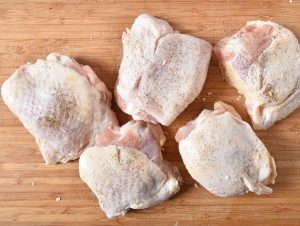
Oysters
Oysters are rounded pieces of dark meat that are found near the back of the thigh. Cooks and gourmets alike prize these pieces highly.

Giblets
Less common now than they once were, the giblets consist of internal organs such as the gizzards, heart and liver. These are occasionally sold separately, but are also sometimes included with the rest of the chicken. The kidneys are also available in many cases.

Liver
A chicken’s liver may be used to make pâté, The Liver is lighty pan seared and blended with butter and either whisky/brandy, to create a rich, velvety smooth pate. It is also used in dog food, it’s high in protein, fat and vitamin A. Its high fat content makes it a particularly good choice for young, growing dogs and underweight dogs.

Feet
Enjoyed as a popular snack food in the Caribbean and China, chicken feet contain little meat, but the skin and cartilage upon them may be flavoured and eaten, Some people claim chicken feet give them calcium and minerals and other people say the collagen in chicken feet even prevents wrinkles.

Neck
Chicken neck is traditionally used in a number of Asian dishes, these are normally deep fried. It may also be stuffed and served as Helzel, a traditional food among Ashkenazi Jews.

Head
Believe it or not, a chicken’s head may also be prepared and eaten as a meal. In China, where it is considered a delicacy, the chicken’s head is split open, allowing the brains and other tissue to be eaten.
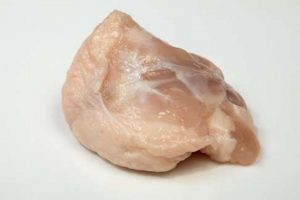
Pygostyle (Tail)
The rear-end of the chicken, pygostyle is not widely sold in most places, although turkey pygostyle (also sold as ‘turkey butt’) is popular in Samoa. It has a pretty high fat content and is not considered to be very healthy. Nevertheless, some people actually eat it. Mainly, however, chicken butts are used in pet food.

Testicles
Apparently, these are quite tasty when grilled and served with soy sauce, although we confess to never actually having the (ahem) balls to try them. They are popular in Asia (especially places like Taiwan), but less so in other areas of the world, for fairly understandable reasons.
The rest of the chicken carcass may be used in multiple ways, including as chicken stock, offal, pet food and other animal products.
The most widely used chicken by-products are their feathers, which have been used to make many things, including animal feed, biodiesel fuel, insulation, upholstery, the absorbent parts of nappies and yes, even plastic.
6. Chicken hygiene
Obviously, it is not safe to consume raw chicken meat (no, not even sashimi), just as it is not safe to consume most forms of raw meat.
Raw fish, such as sushi, may be OK, but this is because the parasites that live in fish are very different critters to the microbes that live in meat.
Sushi is frozen before it is prepared, which kills the potentially harmful organisms that may be living inside it. Freezing meat, on the other hand, does not kill the harmful organisms and bacteria that may be living in the meat, so the danger to you is still very apparent.
The goal when cooking chicken is to get the meat entirely white. Cooked (and therefore safe-to-eat) chicken meat should be white (or brown, depending on how it has been cooked) on the outside and white on the inside. If the inside of the meat is pink or red, you should absolutely stop eating it.
When cooking a whole bird (roasting, for example), you should pierce the thickest part of the leg (between the drumstick and the thigh) and check that the juices that escape are not running pink or red. If they are, more cooking time is needed. The juices will run clear when the meat is fully cooked. If you have any doubts, cook it for longer. Food poisoning is no joke. Some cases can even be fatal.
Here’s a handy little guide that should help you to stay safe when preparing chicken.
Wash your hands – You should always wash your hands before preparing food of any kind. That’s just a no-brainer. Also, wash your hands as soon as you’re finished preparing any kind of raw meat. If you used those same hands to turn the tap on, give that tap a spray and a wipe with some antibacterial formula as well.
Keep a clean kitchen – Wipe the work surfaces and other areas down daily (or as often as possible) with antibacterial spray and other cleaning products. Mop the floors, empty the bins/recycling and clean the fridge with antibacterial products as often as possible.
Use a chopping board – Do not, under any circumstances, prepare raw chicken (or any meat, for that matter) on any unprotected kitchen surface, even one that has been properly cleaned. Always use a chopping board (it helps to have a specific one to use just for raw meat) and allow nothing else to touch that chopping board once it has been used.
Store meat well – Keep your meat in a sealed container, ideally at the bottom of the fridge. You don’t want raw meat juices spilling from the top shelf and dousing your other food products. If meat juices do leak anywhere in the fridge, the fridge must be thoroughly cleaned with antibacterial spray. Any ready-to-eat foods (such as fruit) that touch raw meat must be thrown away immediately. DO NOT leave any meat (raw or otherwise) uncovered, even in the fridge. Also, unless you’re defrosting something, always keep the meat in the fridge or freezer.
Never wash raw chicken – It might seem like a good idea, but running raw chicken meat under a tap in order to clean it is actually a fantastically bad idea. For one, it will do little or nothing to remove the dangerous microbes you’re trying to get rid of and for two, it will send any bacteria it does manage to remove flying outward in all directions, including your hands, your clothes, your favourite coffee mug, last night’s washing up and, well, you get the idea.
Avoid chicken that has spoiled – Sometimes, chicken that’s recently defrosted can smell slightly whiffy. This is usually OK. Let’s face it, even fresh meat doesn’t smell too appetising, but you shouldn’t retch at the smell of any meat. If the raw meat smells sour or is setting off your gag reflex, chuck it out immediately.
Chicken meat that has started to go bad will sometimes become grey instead of light pink. Meat that is greyer than pink should definitely stay off the menu. Chicken that has gone bad will also maintain a duller hue when cooked and may not turn bright white as it is supposed to.
Spoiled chicken will also sometimes be sticky to the touch or look like a thin layer of slime is covering it.
For frozen chicken, avoid meat that appears to be covered by a thick layer of ice. This can mean that it has been improperly frozen and is therefore inedible.
Basically, if you have any doubts at all, we advise you to cut your losses and order a takeaway instead!
Be careful with marinades – You might know all the other stuff here, but this one STILL catches people out, especially those who fancy themselves as a bit of a kitchen whizz.
Don’t ever re-use a marinade that has been used with raw chicken to baste the bird as it cooks. All you’d be doing in this instance is ‘topping’ up the dying bacteria with reinforcements that might not be all gone by the time you serve your meal.
7. How to Cook Chicken
Being a very versatile meat, chicken can be cooked and eaten in a multitude of ways. We will not attempt to list every single method of cooking a chicken, but we will offer a guide to the most popular methods. Maybe there will be one or two you haven’t yet tried?
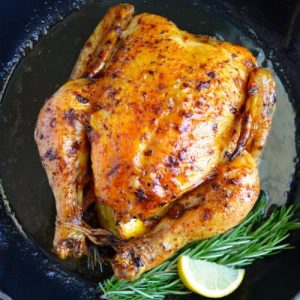
Roasting
A ‘roaster’ is a bird that is older and bigger, with tougher meat and more fat. These birds are excellent when prepared and roasted in a fan-assisted oven (especially with the addition of stuffing).
TIP: Adding the meat juices to the gravy can really give your Sunday roast that little something extra!
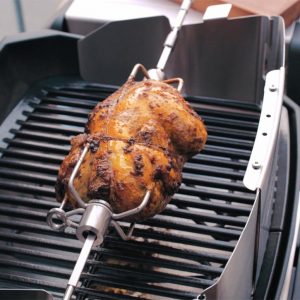
Rotisserie
A whole chicken is skewered and slowly rotated over a heat source. The fat will escape the meat, making it very lean, but the meat juices and fat will rise again as steam and flavour the meat that way. Rotisserie chicken is a popular and tasty dish commonly found in supermarkets throughout the world.

Baking
The term ‘baking’ refers to the cooking of chicken in the same manner as roasting, except that the chicken being oven cooked is in pieces (such as chicken breast).

Pan Frying
Nice and easy. Simply heat up some extra virgin olive oil or garlic butter and add the diced chicken to the pan with some seasoning, vegetables and/or a nice sauce.
TIP: Chicken is very porous meat, and can soak up just about anything it is cooked with. White wine, chicken stock, soy sauce and many other ingredients will strongly influence the flavour of the eventual dish if they are all pan fried together.

Sautéing
This is similar to, but not the same as, pan-frying. The pre-seasoned chicken (often in the form of cutlets, a cut of chicken breast that is flat and evenly laid out) is added to hot oil in a frying pan and cooked (usually without any other ingredients) until sealed. It can then be served with vegetables or in a sauce like a curry, to form a tasty meal.

Stir Frying
To stir fry, simply fry slices or chunks of chicken in a hot pan or wok, along with vegetables, seasoning and sauce. A stir-fry can be served with rice, noodles or both, depending on the chef’s preference.
TIP: Soy sauce soaks into chicken exceptionally well, adding immediate flavour even to cooked meat. Chicken stir-fry is nothing without a little soy sauce. Dark soy is best for this, in our opinion.

Barbeque
Light the barbeque and get a good fire going. Once the fire has died down (remember, it is the heat from the coals that cooks barbequed food, NOT the fire) take your chicken (drumsticks are most commonly used) and place it on the grill. For best results, turn the meat infrequently and try to keep the lid down as much as possible.
TIP: There’s a lot to be said for a good chicken rub, and if you can prepare one before adding the meat to the barbeque, your tastebuds will thank you.

Grilling/Broiling – Yes, there is a difference between these two methods, although they are quite similar. Grilled chicken is cooked from the bottom up, i.e. the heat source is below the chicken. Broiled chicken, on the other hand, is cooked with the heat source above the meat (so, when you place chicken breasts under the grill in your oven, you are in fact broiling them as opposed to grilling them).
TIP: When chicken is grilled, the juices escape the meat and rise back up to the meat as steam, which in turn adds to the flavour. Broiled meat does not enjoy this effect and is usually blander as a result.
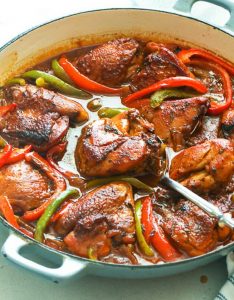
Stewing/Braising
In this method of cooking, the chicken is usually browned, but not cooked right through, and then added to a dish or slow cooker along with water, seasoning and other ingredients. The meat cooks very slowly, allowing for a moist, succulent explosion of flavour when eaten.
TIP: Only slightly cook the meat before adding it to the casserole dish, Crock-pot or slow cooker. Don’t cook it right through or the meat will become tough, rubbery and chewy when it should be soft and moist.
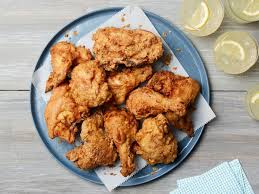
Deep Frying
First, cover smaller sized chicken pieces in breadcrumbs, Flour or batter, then add them to either a deep fat fryer or a saucepan that is half full of boiling oil. Place the pieces into the oil and allow them to cook for about 10 minutes. As long as the oil is hot enough, the meat will cook perfectly.
TIP: Once the chicken is removed from the oil (using tongs), place it onto some kitchen roll in order to drain the grease.
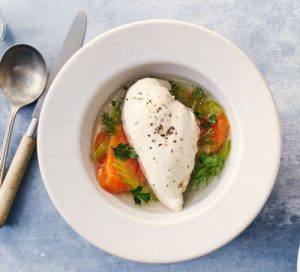
Poaching
This is a very healthy cooking option, because it involves boiling the meat in a pan and adding no fat to it whatsoever. Place the chicken piece(s) into a pot with other ingredients, then cover them entirely with water. Be sure not to use too much water, however, as this dilutes the flavour. If your meat is labelled as ‘stewing’ meat, then this method, or stewing/braising are the best ones to use.
TIP: Once the meat is fully cooked, the liquid can be used as a broth or as part of a sauce and served with the chicken.

Steaming
Like vegetables, chicken can be steamed using a basic kitchen steamer. First, a saucepan of water is boiled on the hob or stove, then the meat is placed above it in the steamer. The meat is then steam-cooked over a period of time. This is a very healthy way to cook meat, as it is largely fat free. It is very good for whole smaller birds such as Cornish Game Hen and boneless chicken breasts.

Shredding
This is more a method of serving than cooking. Once the meat has been cooked (boiling or roasting is best in this case), take two forks, face them away from each other and gently tease the meat apart. With a little bit of patience, you should soon have a pile of shredded chicken that goes great in salads and sandwiches.
8. What Flavours Best Compliment Chicken?
The following is a brief (and by no means exhaustive) list of herbs, spices and flavours that we feel accompany chicken particularly well.
Tarragon, sage, onion, basil, oregano, garlic, lemon, parsley, rosemary, thyme, ginger, pepper, chilli, paprika, cayenne pepper, anise, cumin, coriander, sesame seeds, saffron, jerk seasoning, mixed spice, mixed herbs, all-purpose seasoning, cinnamon, shawarma, tabil, curry powder, berbere, chicken stock and white wine.
Good additions to a chicken meal include sage and onion stuffing, carrots, potatoes, mushrooms, rice, pasta, tomatoes, sun-dried tomatoes, courgettes, bacon, broccoli and peas.
9. Which is Better, Breasts or Legs?
The central difference between breast and leg meat is the fat content. The meat on a chicken’s leg is considerably fattier than its breast meat. In fact, there is roughly three times as much fat in a piece of chicken thigh meat as there is in a piece of breast meat weighing the same amount.
Aside from this key difference, the nutritional qualities of any cut of chicken are basically the same.
This is not to say that the dark meat’s fat content is particularly dangerous to you. Chicken is still a very lean meat and the fat that is found on thigh and leg meat is monosaturated fat can actually aid the human body in losing weight, as well as reducing cholesterol numbers and lessening the risk of heart disease and cancer.
Ultimately, if you require a diet with minimum fat, always choose breast, but thigh meat isn’t bad for you if eaten in moderate quantities.
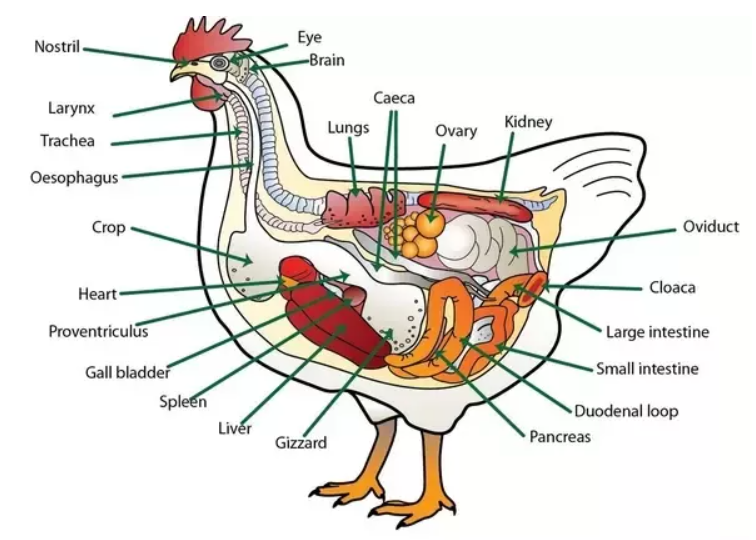
In terms of flavour, well, that’s really your call. Chicken legs do have a stronger flavour (as does dark meat in general), but chicken breast has a more porous quality, which makes it better for mixing with different flavours to create something uniquely your own.
10. Health Benefits of Eating Chicken
Chicken meat is what’s known as ‘lean protein’, in that even just one chicken breast contains around half of our daily protein requirement, but only a gram or so of fat. Protein helps to build muscles and keep us strong. Chicken is also completely free from carbohydrates and can even help you to reduce your appetite.
Chicken meat contains a lot of both phosphorous and calcium, which aids our bones and teeth. In fact, one chicken breast contains about 31% of our recommended daily amount of phosphorus. Chicken is vitamin rich as well, containing vitamin B3 (good for tiredness and fatigue), as well as B5 (which relieves stress) and B6 (which helps the blood form haemoglobin). It also contains a helpful assortment of omega 3 fatty acids.
Chicken meat also contains iron (which is found in greater abundance in the dark meat than the light) as well as zinc, which aids the development of healthy hair and nails, as well as increasing the sperm count in males. It also has a lot of magnesium (which has been shown to soothe PMS symptoms).
Interestingly, chicken soup, which has long been a popular home remedy for colds, flus and other ailments, actually does help to prevent inflammation during times of sickness. In fact, studies have shown that eating chicken soup when unwell can actually boost our immunity.
11. Chickens in Popular Culture
In popular culture, chickens are frequently used for comic effect, such as the classic cartoon character Foghorn Leghorn, HeiHei from Disney’s ‘Moana’, Peter Griffin’s recurring nemesis Ernie from ‘Family Guy’ or the titular Robot Chicken from the opening credits of ‘Robot Chicken’.
They can act as a synonym for cowardice, like in the movie ‘Monty Python & The Holy Grail’ where ‘Very Brave’ Sir Robin uses a chicken as his standard.
However, chickens can also be depicted as brave or heroic figures, such as the Pokèmon Blaziken or the heroines of the animated movie ‘Chicken Run’. In some depictions, chickens can be seen as intelligent characters like Gyro Gearloose in ‘Duck Tales’.
Chickens can be corporate logos, like Cornelius the rooster from Kellogg’s Corn Flakes or the identifying images used by film company Pathè or sportswear manufacturers Le Coq Sportif. A chicken is even the national symbol of France.
In stories, chickens may morph into mythical monsters like the European cockatrice or Japanese Basan. Chickens appear in many folk tales from around the world – and not just ancient stories, either. A cockerel is one of the four musicians of Bremen in the Brother’s Grimm fairy tale, lest we forget.
We even sing about chickens, such as the Willie Dixon Blues standard ‘Little Red Rooster’, sung by Howlin’ Wolf and later covered by The Rolling Stones or ‘Chicken’ by Sly & The Family Stone.
Yes, chickens are almost as populous in our popular culture as they are in the real world.
..And after all that, we STILL don’t know why he crossed the road!
12. Hats Off to the Chickens!
Billions of chickens give their lives every year so that we can go on living. Often, they are kept in intolerable conditions and live their short, uncomfortable lives in pain or distress.
The humble chicken, once hailed as an exotic, sometime sacred ‘Persian bird’ by the ancient Greeks, is not, in many cases, being given the respect she so clearly deserves, having been a staple of the human diet since time immemorial.
In recent years, positive steps have been taken to rectify this, with legislation being passed that aims to wipe out battery farming altogether, but the life of a free range, organic chicken still isn’t all that great – and, in our view, more work is needed.
The chicken is a vibrant, intelligent animal, one that has helped to sustain our species for many thousands of years. They have complex social lives (hence the term ‘pecking order’) and they can employ logic to solve problems. Studies have shown that chickens can be deceitful (a complex cognitive behaviour) and they can even be taught simple addition and subtraction. Interestingly, research has demonstrated that chickens experience both positive and negative emotions, which makes their treatment at the hands of battery farmers all the more damning.
The chicken represents so many things to us humans. It is the dietary staple that produces another dietary staple. It is the most common livestock animal in the world, but despite this ubiquity, the chicken remains one of the least understood members of the animal kingdom. Like us, it is a creature of great variety and incredible beauty that is capable of intense brutality and aggression in times of upset.
What is the chicken? Is it a bird? Is it a food? Is it a friend? The answer, perhaps predictably, is that it is all three. Chickens are no longer considered to be sacred animals by most people, but we think you’ll agree that they’re still pretty clucking special.
